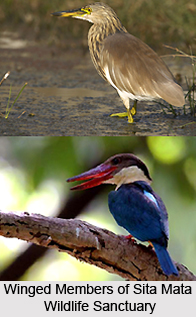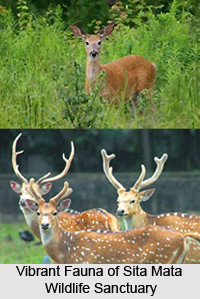 Sita Mata Wildlife Sanctuary, located in the south eastern region of the Pratapgarh district of the Indian state Rajasthan, is a wildlife refuge encompassing dense forested area. The sanctuary was notified by Government of Rajasthan in the year 1979. It includes a huge expanse of 422.95 square kilometres which covers about 40 percent of the total land area in the district. It serves as a major tourist attraction of Pratapgarh. The undulating topography of the region witnesses the confluence of three different geological formations namely Aravali ranges, Vindhyachal Hills and Malwa Plateau.
Sita Mata Wildlife Sanctuary, located in the south eastern region of the Pratapgarh district of the Indian state Rajasthan, is a wildlife refuge encompassing dense forested area. The sanctuary was notified by Government of Rajasthan in the year 1979. It includes a huge expanse of 422.95 square kilometres which covers about 40 percent of the total land area in the district. It serves as a major tourist attraction of Pratapgarh. The undulating topography of the region witnesses the confluence of three different geological formations namely Aravali ranges, Vindhyachal Hills and Malwa Plateau.
Geography of Sita Mata Wildlife Sanctuary
Sita Mata Wildlife Sanctuary lies at an altitude ranging from 280 and 600 metres above average sea level. It receives an average rainfall of about 756 millimetres annually. During summers the temperature varies from 32 to 45 degree Celsius whereas during winters it varies from 6 to 14 degree Celsius. Seasonal rivers including Tankiya, Budhho, Sitamata, Karmoi and Jakham meander through the dense forest among which Jakham is the most significant one.
Flora of Sita Mata Wildlife Sanctuary
The main vegetation of Sita Mata Wildlife Sanctuary comprises dry deciduous forest which exhibits an extremely rich flora. Most of the vegetation in the sanctuary consists of Teak with high building value. Other trees include Neem, Babool, Peepal,
 Tendu, Salar, Bamboo, Ashok, Arinja, Mahua, Amla, Semal, Bel and many others. Shrubs and climbers are also found in abundance. Several herbs having high medicinal value grow in the forest out of which 17 varieties belong to the endangered species. In olden days, 1828 AD, a separate state forest department was established for managing the rich biodiversity of this region.
Tendu, Salar, Bamboo, Ashok, Arinja, Mahua, Amla, Semal, Bel and many others. Shrubs and climbers are also found in abundance. Several herbs having high medicinal value grow in the forest out of which 17 varieties belong to the endangered species. In olden days, 1828 AD, a separate state forest department was established for managing the rich biodiversity of this region.
Fauna of Sita Mata Wildlife Sanctuary
Sita Mata Wildlife Sanctuary is a paradise for bird watchers as the place hosts a huge assemblage of exotic birds including both native as well as migratory. Common varieties found here comprise White Necked Stork, Painted Stork, Little Egret, Lesser Whistling Thrush, Black-Winged Stilt, Red Turtle Dove, Green Pigeon, Rose-Ringed Parakeet and others. The birds Black-Necked Monarch and White-Throated Ground Thrush were discovered in the sanctuary only. Vegetarian Mammal Flying Squirrel is the most attractive member of Sita Mata Wildlife Sanctuary which glides from one tree to another. Having nocturnal feeding activities, these species hides in the hollow of Mahua tree during day time. Other fauna of the sanctuary include Wild Bear, Spotted Deer, Porcupine, Jungle Cat, Jackal, Hyena, Leopard, Pangolin, Caracal, Four-Horned Antelope, Deer and others.
Visiting Information
Sita Mata Wildlife Sanctuary is best visited between the period of October and February. It is well connected with major Indian cities through roadways. Mandsaur (in Madhya Pradesh) situated at a distance of 28 kilometres is the nearest railway station whereas Dabok Airport in Udaipur, 145 kilometres away is a nearest airport. The sanctuary also hosts the Valmiki Ashram which is believed to be the birthplace of Luv and Kush of the Hindu epic Ramayana. Hanuman and Sitamata temples are also located here which possesses mythological as well as historical significance. Lakhiya Bhata, situated near the sanctuary is another tourist attraction which houses a series of engravings depicting prehistoric animals. In the month of July an annual fair is held in the sanctuary.











